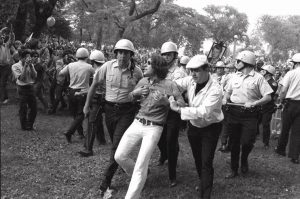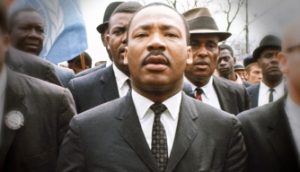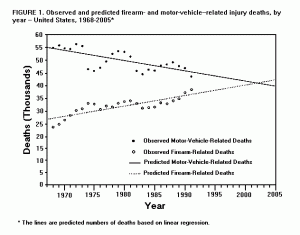What place have we come to?
I grew up in a country with strict gun control laws. In New Zealand in the 1940s and ‘50s, you needed a permit and a “proper and sufficient purpose” to acquire a firearm, and all weapons had to be licensed and registered. Automatic pistols were outlawed altogether. My dad kept a rifle in a locked closet, taking it out occasionally to go hunting for feral pigs with his friends. But guns were not part of my small town landscape. Even today, New Zealand police officers do not routinely carry firearms.
Imagine my state of mind then, when the newspapers of my newly adopted country ran daily news stories about firearm-related deaths. Looking back now at government statistics, I see that in 1968 the US, with a population of 200.7 million, had about 31,400 firearm deaths. (Since the Center for Disease Control bundled multiple years 1968-1980, this is an average.) CDC, in a 1994 report, predicted that people killed by firearms would by 2003 outnumber vehicle crash-related deaths. Louis Jacobson, in a PunditFact article, verifies Nicholas Kristof’s 2015 statement that “More Americans have died from guns in the United States since 1968 than on battlefields of all the wars in American history.”
On April 4, 1968, our family had been in the US less than a year. My husband Tony was in Washington, DC for an international magnetics conference. On March 30 I wrote to my parents: He is very excited about this, especially as he hopes to meet some of his friends from England who are expected there.
About a week later I wrote again:
10 April 1968
Tony also got involved last week in America’s other big trauma – the race riots following Dr. King’s assassination. He had great difficulty getting out of Washington on Friday [April 5], but fortunately the flight crew of his plane had the same problem, so managed to catch his correct flight a couple of hours late. I gather that the conference was very successful and useful, if somewhat exhausting.
Reading these words again today, I notice the calm, distancing tone. I couldn’t tell my parents that I was terrified. Tony had described to me the view from the night sky: cities in flames all across America.
Two months later, on June 5, 1968, presidential candidate Robert F. Kennedy was fatally shot at the Ambassador Hotel in Los Angeles, shortly after winning the California presidential primaries in the 1968 election.

Police lead a demonstrator from Grant Park during demonstrations that disrupted the Democratic National Convention in Chicago in August 1968. (AP) Image from https://www.washingtonpost.com/
Yet more public and political mayhem was to come. In August we endured reports of the violent clashes between police and protesters at the 1968 Democratic National Convention in Chicago. In its report Rights in Conflict (better known as the Walker Report), the Chicago Study Team that investigated the incident stated that the police response was characterized by:
…unrestrained and indiscriminate police violence on many occasions, particularly at night. That violence was made all the more shocking by the fact that it was often inflicted upon persons who had broken no law, disobeyed no order, made no threat. These included peaceful demonstrators, onlookers, and large numbers of residents who were simply passing through, or happened to live in, the areas where confrontations were occurring.
I have to agree with Haynes Johnson, a Pulitzer Prize-winning reporter who was covering the convention. He wrote in a 2013 Smithsonian Magazine story that the convention was
…a lacerating event, a distillation of a year of heartbreak, assassinations, riots and a breakdown in law and order that made it seem as if the country were coming apart.


Richard and I lived about 30 miles west of Chicago at the time of the Democratic convention. We seriously considered joining the demonstrations outside the convention. We had friends who were willing to stay at our house with their son and care for Chris and Diana. As the time came closer we decided to stay home and watch on TV. You know that feel of oh my I could have been in a dangerous situation. Most of the demonstrators were located where the police were pushing people to leave but other police were blocking the limited exit bridges. There was no way to stay and no way to leave. I still have my copy of the Walker report.
I lived through those days in So. California. Born and raised in the U.S. I was stunned and heartsick at the level of violence. I shed tears for my country and for the loss of lives. There is still a lot of violence due to drugs and gangs, it is such a different country than when I was young. If guns are banned in this country it will only punish the people who want to own a gun responsibly and legally. The criminals and gang members have no problem getting illegal weapons.
Your piece gave me chills, Maureen, remembering those sobering and traumatic days.
What an interesting vantage point you’ve had on history! Fascinating details.
Maureen, I don’t remember that we ever discussed these issues in the early days of our friendship. I imagine I was looking at the events with a different lens, but I know that I was appalled at the treatment of peaceful demonstrators. I recall a lack of understanding of why anyone would want to destroy their own communities with fire and violence. Eventually, I began to see all that was wrong with the kind of control being carried out. As you remember the next few years of my personal life were somewhat harrowing. Fortunately, by the mid 70’s I became much more conscious of the inequities that existed and still exist.
As always, I appreciate your perspective on past events.
Love to you both for being part of my enlightenment,
Judi